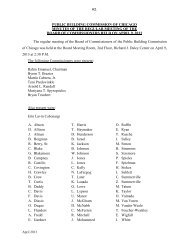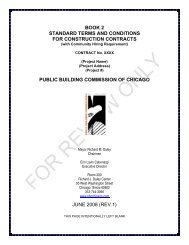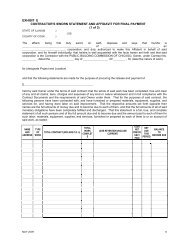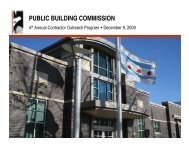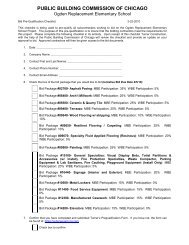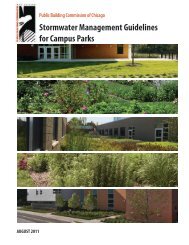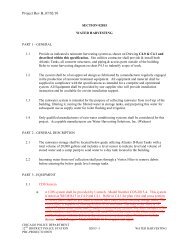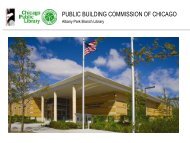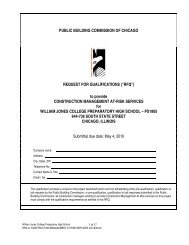Water Reuse Handbook - the Public Building Commission of Chicago
Water Reuse Handbook - the Public Building Commission of Chicago
Water Reuse Handbook - the Public Building Commission of Chicago
You also want an ePaper? Increase the reach of your titles
YUMPU automatically turns print PDFs into web optimized ePapers that Google loves.
<strong>Water</strong> <strong>Reuse</strong> <strong>Handbook</strong><br />
42 : <strong>Public</strong> <strong>Building</strong> <strong>Commission</strong> <strong>of</strong> <strong>Chicago</strong><br />
Learning curve: The Illinois Department <strong>of</strong> <strong>Public</strong> Health (IDPH),<br />
<strong>the</strong> City <strong>of</strong> <strong>Chicago</strong> Department <strong>of</strong> <strong>Building</strong>s, and <strong>the</strong> Committee on<br />
Standards & Tests (CST) reviewed <strong>the</strong> system. IDPH required changes<br />
including modifying <strong>the</strong> disinfection and filtration components, <strong>the</strong><br />
incorporation <strong>of</strong> backflow prevention, and signage to indicate that<br />
<strong>the</strong> system’s water is non-potable (including signage with yellow<br />
lettering on all fixtures flushed with Harvested Rainwater). IDPH<br />
required <strong>the</strong> plumbing contractor to repipe <strong>the</strong> UV sterilizer to ensure<br />
that UV sterilization would occur prior to rainwater entering <strong>the</strong> day<br />
tank. In addition, CST required a custom-fabricated air gap fitting<br />
to meet <strong>the</strong> City requirements to keep harvested water out <strong>of</strong> <strong>the</strong><br />
municipal supply.<br />
Post-Installation Maintenance: Staff will need to change UV bulbs about once every<br />
three seasons or after 10,000 hours <strong>of</strong> use; <strong>the</strong> UV system has an<br />
hours-run meter to indicate when <strong>the</strong> bulb needs to be changed.<br />
Due to <strong>the</strong> fact that <strong>the</strong> building is not heated (it is shut down during<br />
<strong>the</strong> winter months), winterization is necessary at <strong>the</strong> end <strong>of</strong> <strong>the</strong><br />
summer and includes draining <strong>the</strong> day tank, both UVs , and <strong>the</strong> pump<br />
inside <strong>the</strong> building.<br />
Monitoring: Remote panel will display: (1) volume <strong>of</strong> rainwater<br />
harvested; (2) volume <strong>of</strong> municipal water used as backup; (3) volume<br />
<strong>of</strong> water in underground storage; and (4) indicator light for when <strong>the</strong><br />
UV bulb needs replacing or if <strong>the</strong>re is a problem with <strong>the</strong> UV system.<br />
<strong>Water</strong> quality monitoring is not being performed.<br />
Lessons learned: The team learned that <strong>the</strong>y should allow additional<br />
time to get <strong>the</strong> rainwater harvesting system through <strong>the</strong> nonstandard<br />
review process involving <strong>the</strong> State and CST. Until water reuse<br />
standards are codified, future projects should budget additional time<br />
and expect some level <strong>of</strong> design changes to <strong>the</strong> system.<br />
The solenoid valves initially did not work at <strong>the</strong> beach houses, which<br />
shut down <strong>the</strong> rainwater harvesting systems.<br />
Local Case Studies: Beach Houses<br />
August 2011



